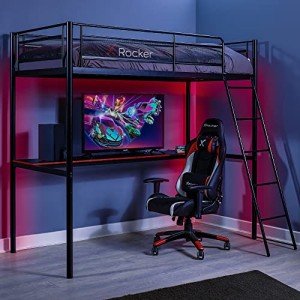Bunk beds have long been a staple in kids's bed rooms, offering a combination of space-saving effectiveness and fun. Whether accommodating brother or sisters, good friends on pajama parties, or simply making the most of a playroom, bunk beds have actually ended up being a necessary element in modern-day household homes. As sales on bunk beds increase, it becomes significantly important for customers to make informed choices when purchasing one. This article will cover the fundamentals of buying a bunk bed, from types to safety functions, along with pointers for maintaining the integrity of your investment.
When considering a bunk bed sale, it's important to understand the different styles readily available on the market. Below are the most common types:
Traditional Bunk Beds: These consist of two beds stacked one above the other, sharing a single frame. They are typically the most affordable alternative.
L-Shaped Bunk Beds: This style includes one bed placed vertically and another horizontally. This plan develops additional space beneath the upper bed, which can be utilized for storage or a backyard.
Lofted Beds: Similar to standard bunk beds but with no lower bed. Instead, the space below can be made use of for a desk, play area, or extra storage.
Triple Bunk Beds: For families with a bigger number of kids or regular pajama parties, triple bunk beds supply 3 sleeping locations in a space-efficient style.
Futon Bunk Beds: These styles combine bunk beds and futon sofas. The bottom area converts into a separate seating location, boosting performance.
Convertible Bunk Beds: These beds can be separated into two specific beds, making them versatile as children's needs alter over time.
| Type | Description | Space Efficiency | Extra Features |
|---|---|---|---|
| Standard Bunk Bed | 2 beds stacked vertically | High | Easiest style |
| L-Shaped Bunk Bed | One vertical and one horizontal bed | Moderate | Play or storage space |
| Lofted Bed | Elevated bed with open space below | High | Work/play location |
| Triple Bunk Bed | 3 stacked beds | Extremely High | Accommodates more users |
| Futon Bunk Bed | Bunk bed with a convertible futon | High | Multi-functional |
| Convertible Bunk Bed | Can be split into 2 separate beds | Moderate | Versatility & & longevity |
Security is critical when buying a bunk bed. Below are key safety features to try to find:
Guardrails: Adequate guardrails should be present on both sides of the upper bunk to avoid falls. They must be at least 5 inches greater than the bed mattress.
Ladder Design: Look for sturdy, wide ladders with slip-resistant rungs. Ensure that the angle is not too high for simple gain access to.
Stability: Ensure the bed is constructed with strong materials, such as strong wood or sturdy metal. The bed should not wobble when in use.
Weight Limit: Check the weight capability of the bunk bed to ensure it can accommodate the desired users safely.
Product Safety: If possible, choose beds made from non-toxic materials or those satisfying security standards for kids's furniture.
| Feature | Description | Value |
|---|---|---|
| Guardrails | Sides of upper bed to avoid falls | Vital for kid safety |
| Ladder Design | Strong, slip-resistant rungs | Help safe and simple access |
| Stability | Develop quality to avoid wobbling | Ensures security and durability |
| Weight Limit | Maximum weight capacity | Avoids mishaps |
| Product Safety | Non-toxic, safe materials | Protects kids's health |
To extend the life of your bunk bed and guarantee continuous safety, think about the following upkeep pointers:
Regular Inspections: Periodically examine the structure for loose screws, bolts, or any signs of wear. Tighten fasteners as required.
Tidy Periodically: Dust and tidy the surfaces regularly. Usage suitable cleaners that won't harm the surface.
Check Weight Limits: Be mindful of weight limits, particularly with older kids or adults who may wish to use the upper bunk.
Prevent Climbing on Guardrails: Educate kids not to use guardrails for climbing up or playing to decrease the threat of accidents.
Q1: What is the age limit for children to securely use bunk beds?A: While it differs by the producer, many suggest that kids under 6 should not sleep in the upper bunk due to security concerns.

Q2: How can moms and dads dissuade hazardous climbing?A: Setting clear guidelines about bunk bed usage and monitoring children can help. In addition, utilizing a bed tent can discourage climbing while creating a fun sleep environment.
Q3: What should I consider when embellishing a room with bunk beds?A: Ensure there suffices space around the bunk bed for safe movement, and make use of the decoration to create individualized spaces for each child.
Q4: Is a lofted bed appropriate for older kids?A: Yes, lofted beds can be ideal for older kids as long as they fulfill security requirements and the child is accountable enough to use them securely.
Bunk beds serve a practical purpose while including an element of fun to a kid's bed room. As sales of bunk beds continue to rise, mindful factor to consider of types, safety functions, and maintenance practices is necessary for moms and dads and caretakers. By understanding these essential aspects, households can find the best bunk beds sale bed for their home, ensuring both practicality and security for several years to come. Whether it's for siblings sharing a space or producing a cozy slumber party space, a well-chosen bunk bed can supply pleasure and practicality, making it a deserving investment.
No Data Found!
